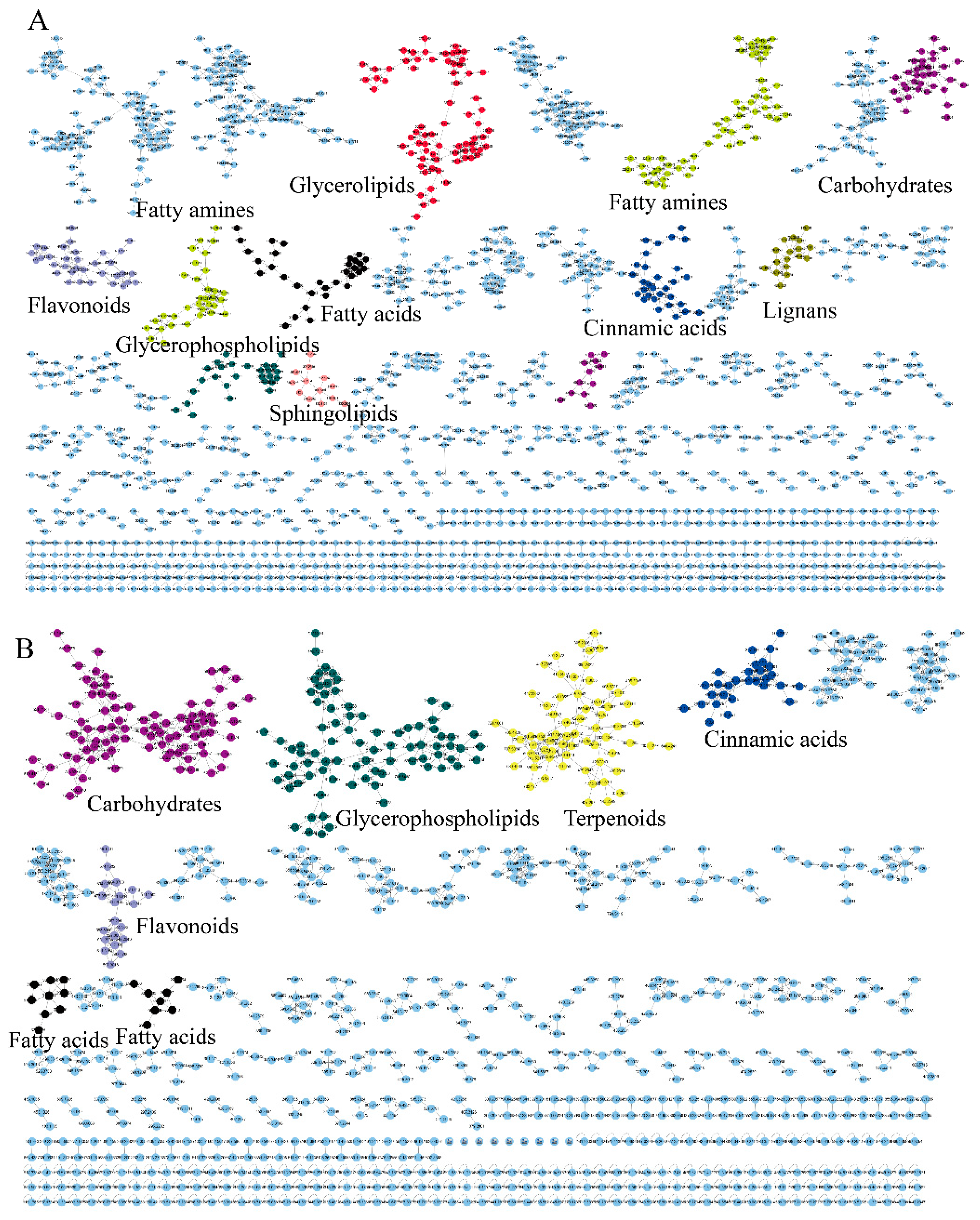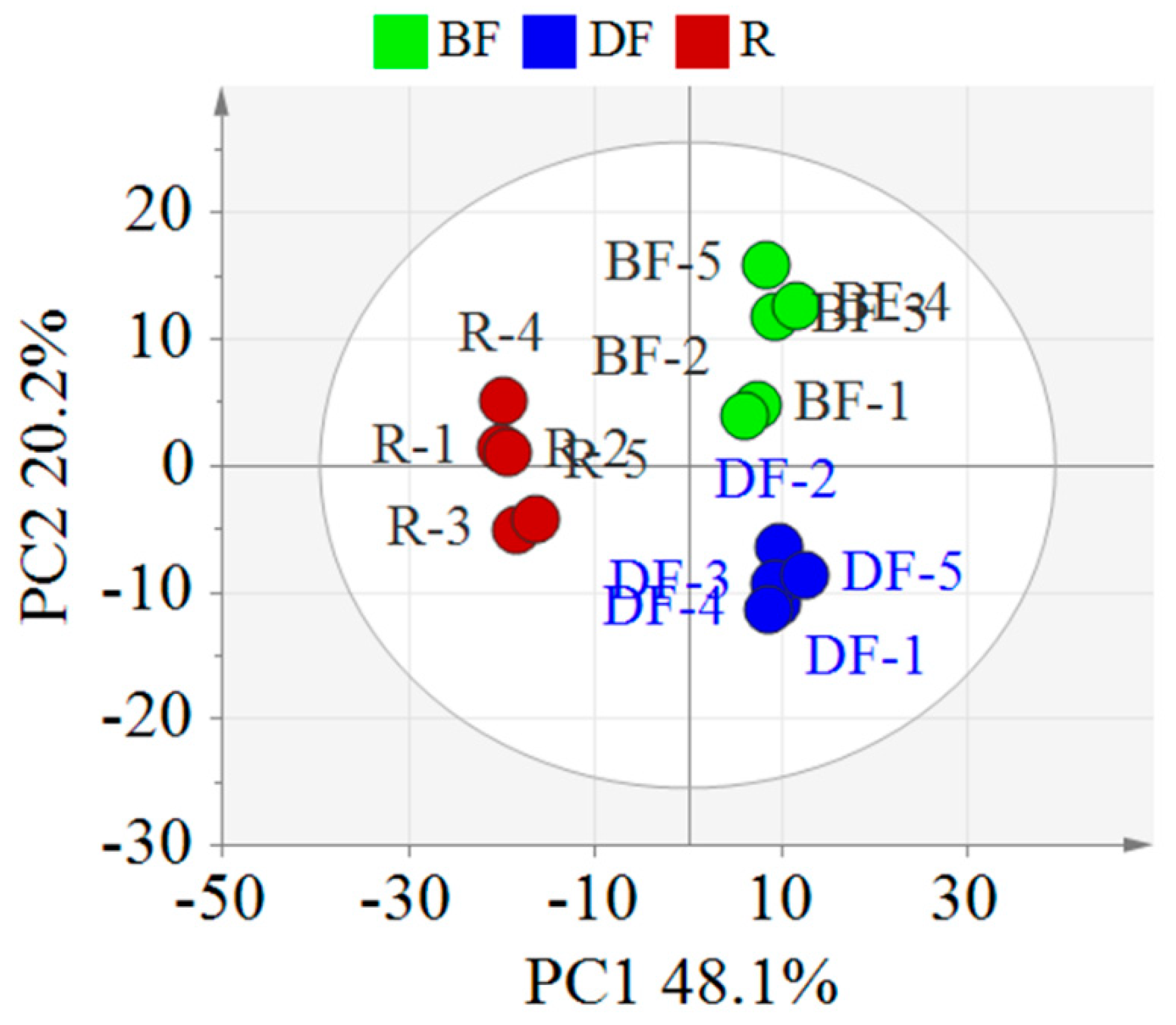Profiling and Discrimination of Euryale Ferox Seeds from Different Processing Methods Using Liquid Chromatography High-Resolution Mass Spectrometry Combined with Molecular Networking and Statistical Analysis
Abstract
:1. Introduction
2. Materials and Methods
2.1. Samples and Chemical Reagents
2.2. Preparation of Sample
2.3. LC-HRMS Analysis
2.4. Data Preprocessing and Statistical Analysis
3. Results and Discussion
3.1. Identification of Chemical Constituents in EFSs
3.1.1. Identification by Searching Databases
Identification of Fatty Acids and Derivatives
Identification of Glycerophospholipids
Identification of Carbohydrates and Conjugates
Identification of Flavonoids and Derivatives
3.1.2. Identification Through Propagation
3.2. Discrimination of EFSs from Different Processing Methods by Multivariate Statistical Analysis
3.2.1. Statistical Analysis Between REFSs and DFEFSs
3.2.2. Statistical Analysis Between REFSs and BFEFSs
4. Conclusions
Supplementary Materials
Author Contributions
Funding
Institutional Review Board Statement
Informed Consent Statement
Data Availability Statement
Conflicts of Interest
References
- Gao, Z.X.; Qu, C.; Yan, H.; Xia, L.; Guo, S.; Zhan, Z.L. Herbal Textual Research on Euryales Semen in Famous Classical Formulas. Chin. J. Exp. Tradit. Med. Formulae 2024, 30, 210–217. [Google Scholar] [CrossRef]
- Row, L.C.; Ho, J.C.; Chen, C.M. Cerebrosides and Tocopherol Trimers from the Seeds of Euryale ferox. J. Nat. Prod. 2007, 70, 1214–1217. [Google Scholar] [CrossRef] [PubMed]
- Sun, H.L.; Zhang, Y.Q.; Xie, Y.Q.; Che, Y.Y. Studies on Chemical Constituents from Seeds of Euryale ferox. J. Chin. Med. Mater. 2014, 37, 2019–2021. [Google Scholar] [CrossRef]
- Jiang, J.; Ou, H.; Chen, R.; Lu, H.; Zhou, L.; Yang, Z. The Ethnopharmacological, Phytochemical, and Pharmacological Review of Euryale ferox Salisb.: A Chinese Medicine Food Homology. Molecules 2023, 28, 4399. [Google Scholar] [CrossRef]
- Chen, W.; Luo, H.; Zhong, Z.; Wei, J.; Wang, Y. The Safety of Chinese Medicine: A Systematic Review of Endogenous Substances and Exogenous Residues. Phytomedicine 2023, 108, 154534. [Google Scholar] [CrossRef]
- Ye, X.D.; Shi, L.F.; Chen, C.Y.; Kuang, L.; Zhong, L.Y.; Chen, W. Optimization of the Processing Technology of Wheat Bran Stir-Fried Euryales Seme Based on AHP-Entropy Weight Method and Response Surface Methodology. J. Chin. Med. Mater. 2024, 47, 1141–1146. [Google Scholar] [CrossRef]
- Wang, H.; Wu, Q.; Wu, C.; Jiang, Z. Simultaneous Determination of 16 Nucleosides and Nucleobases in Euryale ferox Salisb. by Liquid Chromatography Coupled with Electro Spray Ionization Tandem Triple Quadrupole Mass Spectrometry (HPLC-ESI-TQ-MS/MS) in Multiple Reaction Monitoring (MRM) Mode. J. Chromatogr. Sci. 2015, 53, 1386–1394. [Google Scholar] [CrossRef]
- Liu, A.L.; Wang, Y.H.; Wang, T.Y.; Zhu, Y.; Wu, P.; Li, L.J. Comparative metabolomic profiling of secondary metabolites in different tissues of Euryale ferox and functional characterization of phenylalanine ammonia-lyase. Ind. Crops Prod. 2023, 195, 116450. [Google Scholar] [CrossRef]
- Song, C.W.; Wang, S.M.; Zhou, L.L.; Hou, F.F.; Wang, K.J.; Han, Q.B.; Cheng, Y.X. Isolation and Identification of Compounds Responsible for Antioxidant Capacity of Euryale ferox Seeds. J. Agric. Food Chem. 2011, 56, 1199–1204. [Google Scholar] [CrossRef]
- Cai, X.; Wu, J.; Lian, Y.; Yang, S.; Xue, Q.; Li, D.; Wu, D. Characterization and Discrimination of Marigold Oleoresin from Different Origins Based on UPLC-QTOF-MS Combined Molecular Networking and Multivariate Statistical Analysis. Metabolites 2024, 14, 225. [Google Scholar] [CrossRef]
- Lv, Y.; Xu, X.; Wei, Y.; Shen, Y.; Chen, W.; Wei, X.; Wang, J.; Xin, J.; He, J.; Zu, X. Characterization and Discrimination of Ophiopogonis Radix with Different Levels of Sulfur Fumigation Based on UPLC-QTOF-MS Combined Molecular Networking with Multivariate Statistical Analysis. Metabolites 2023, 13, 204. [Google Scholar] [CrossRef] [PubMed]
- Wu, C.W.; Hong, F.; Xiu, H.Y.; Wei, W.; Qi, N. Leaves as a Potential Source of Anthocyanins: Extraction Optimization, Identification and Antioxidant Activities Evaluation. Waste Biomass Valorization 2020, 11, 4327–4340. [Google Scholar] [CrossRef]
- Wu, C.; Chen, R.; Wang, X.S.; Shen, B.; Yue, W.; Wu, Q. Antioxidant and Anti-fatigue Activities of Phenolic Extract from the Seed Coat of Euryale Ferox Salisb. and Identification of Three Phenolic Compounds by LC-ESI-MS/MS. Molecules 2013, 18, 11003–11021. [Google Scholar] [CrossRef] [PubMed]
- Zhang, L.; Zeng, J.; Yuan, E.; Chen, J.; Zhang, Q.; Wang, Z.; Yin, Z.J. Extraction, Identification, and Starch-Digestion Inhibition of Phenolics from Euryale Ferox Seed Coat. J. Sci. Food Agric. 2023, 103, 3437–3446. [Google Scholar] [CrossRef]
- Cheng, T.F.; Jin, H.Z.; Liu, C.X.; Zhang, W.D. LC-MS/MS-based Molecular Networking Producing Enlighten Study of Chinese Materia Medica. Chin. Tradit. Herb. Drug 2018, 49, 265–273. [Google Scholar] [CrossRef]
- Baskiyar, S.; Ren, C.; Heck, K.L.; Hall, A.M.; Gulfam, M.; Packer, S.; Seals, C.D.; Calderon, A.I. Bioactive Natural Products Identification Using Automation of Molecular Networking Software. J. Chem. Inf. Model. 2022, 62, 6378–6385. [Google Scholar] [CrossRef]
- Zhang, Y.; Liao, J.; Le, W.; Zhang, W.; Wu, G. In-Depth Analysis of Molecular Network Based on Liquid Chromatography Coupled with Tandem Mass Spectrometry in Natural Products: Importance of Redundant Nodes Discovery. Anal. Chem. 2024, 96, 15888–15897. [Google Scholar] [CrossRef]
- Deng, Q.T.; Qi, Y.; Wang, Q.H. Processing Evolution and Modern Research Progress of Euryale Ferox. China Pharm. 2022, 33, 1911–1915. [Google Scholar] [CrossRef]
- Yan, Z.; Ning, J.; Luo, Z.; Li, D.; Wang, H.; Xie, X. Systematic Analysis of the Chemical Components of Gentiana urnula Harry Sm Using SIRIUS and Liquid Chromatography High-Resolution Mass Spectrometry. Rapid Commun. Mass. Spectrom. 2025, 39, e10005. [Google Scholar] [CrossRef]
- Moe, M.K.; Strom, M.B.; Jensen, E.; Claeys, M. Negative Electrospray Ionization Low-Energy Tandem Mass Spectrometry of Hydroxylated Fatty Acids: A Mechanistic Study. Rapid Commun. Mass. Spectrom. 2004, 18, 1731–1740. [Google Scholar] [CrossRef]
- Pham, H.T.; Julian, R.R. Radical Delivery and Fragmentation for Structural Analysis of Glycerophospholipids. Int. J. Mass. Spectrom. 2014, 370, 58–65. [Google Scholar] [CrossRef]
- Mutenda, K.E.; Matthiesen, R. Analysis of Carbohydrates by Mass Spectrometry. In The Art of Carbohydrate Analysis; Techniques in Life Science and Biomedicine for the Non-Expert; Springer: Cham, Switzerland, 2021. [Google Scholar] [CrossRef]
- Moyo, B.; Novokoza, Y.; Tavengwa, N.T.; Kuhnert, N.; Lobb, K.; Madala, N.E. Rationalising the Retro-Diels-Alder Fragmentation Pattern of Viscutins using Electrospray Interface-Tandem Mass Spectrometry Coupled to Theoretical Modelling. Rapid Commun. Mass. Spectrom. 2023, 37, e9592. [Google Scholar] [CrossRef] [PubMed]
- Yang, X.; He, Y.N.; Hou, Y.S.; Zhang, D.K.; Yang, M. Analysis and Review of Current Situation of Aconiti Lateralis Radix Praeparata Attenuating Methods based on Patent Perspective. Chin. Tradit. Herb. Drug 2024, 55, 3168–3178. [Google Scholar] [CrossRef]
- Tang, P.P.; Ye, X.R.; Xia, W.J.; Duan, Y.C.; Ding, Q.F. Analysis on Content Rule of Main Characteristic Components in Stir-frying Temperature and Time of Scutellariae Radix. Chin. J. Ethnomed. Ethnophar. 2022, 31, 31–37. [Google Scholar] [CrossRef]
- Huang, L.L.; Jiang, K.H.; Li, Q.; Yang, J.; Hu, Y.; Li, L. Study for the Effect on Structure and Properties of Highland Barley Proteins During Stirfrying. Sci. Technol. Cereals Oils Foods 2025, 33, 105–112. [Google Scholar] [CrossRef]






Disclaimer/Publisher’s Note: The statements, opinions and data contained in all publications are solely those of the individual author(s) and contributor(s) and not of MDPI and/or the editor(s). MDPI and/or the editor(s) disclaim responsibility for any injury to people or property resulting from any ideas, methods, instructions or products referred to in the content. |
© 2025 by the authors. Licensee MDPI, Basel, Switzerland. This article is an open access article distributed under the terms and conditions of the Creative Commons Attribution (CC BY) license (https://creativecommons.org/licenses/by/4.0/).
Share and Cite
Xie, X.; Zeng, C.; Zhang, R.; Zhu, W.; Li, H.; Huang, Z. Profiling and Discrimination of Euryale Ferox Seeds from Different Processing Methods Using Liquid Chromatography High-Resolution Mass Spectrometry Combined with Molecular Networking and Statistical Analysis. Metabolites 2025, 15, 225. https://doi.org/10.3390/metabo15040225
Xie X, Zeng C, Zhang R, Zhu W, Li H, Huang Z. Profiling and Discrimination of Euryale Ferox Seeds from Different Processing Methods Using Liquid Chromatography High-Resolution Mass Spectrometry Combined with Molecular Networking and Statistical Analysis. Metabolites. 2025; 15(4):225. https://doi.org/10.3390/metabo15040225
Chicago/Turabian StyleXie, Xiaoyu, Chuntao Zeng, Ruonan Zhang, Wenting Zhu, Huijie Li, and Zhi Huang. 2025. "Profiling and Discrimination of Euryale Ferox Seeds from Different Processing Methods Using Liquid Chromatography High-Resolution Mass Spectrometry Combined with Molecular Networking and Statistical Analysis" Metabolites 15, no. 4: 225. https://doi.org/10.3390/metabo15040225
APA StyleXie, X., Zeng, C., Zhang, R., Zhu, W., Li, H., & Huang, Z. (2025). Profiling and Discrimination of Euryale Ferox Seeds from Different Processing Methods Using Liquid Chromatography High-Resolution Mass Spectrometry Combined with Molecular Networking and Statistical Analysis. Metabolites, 15(4), 225. https://doi.org/10.3390/metabo15040225





